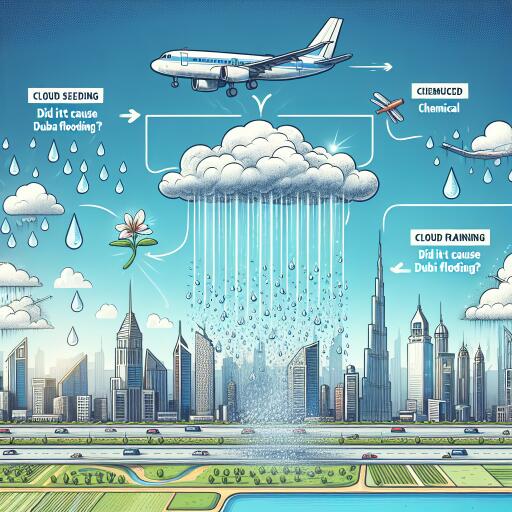
EXPLAINER: What is cloud seeding and did it cause Dubai flooding?
In an unforeseen turn of events, Dubai recently experienced a deluge, recording rainfall levels unprecedented in its history. This unusual meteorological phenomenon has ignited a flurry of speculation and queries regarding its origins, particularly the potential involvement of cloud seeding activities. Let’s delve into the details to untangle the facts from fiction.
The Rarity of Rainfall in Dubai
Renowned for its arid climate, Dubai typically receives less than 100mm of rainfall annually. However, the recent storm took everyone by surprise as Al-Ain, a city near Dubai, witnessed around 256mm of rain in just 24 hours. This extreme weather event was attributed primarily to a “cut-off” low-pressure system that attracted warm, moist air, blocking other weather systems from moving through and leading to significant rainfall. Such heavy downpours are known to be infrequent but not entirely absent from the records in this region.
Climate Change: A Contributing Factor?
The immediate association of such extreme weather events with climate change is inevitable, but pinpointing the exact impact of global warming on this specific instance requires detailed scientific analysis. Nonetheless, the basics of climate science suggest that as the atmosphere warms, its capacity to hold moisture increases—approximately 7% more moisture for every degree Celsius of warming. This principle supports the theory that climate change can intensify rainfall events, making them more potent and potentially catastrophic. Predictive studies indicate that the UAE could see up to a 30% increase in annual rainfall by century’s end if current warming trends persist.
Dispelling the Cloud Seeding Myths
Cloud seeding has been thrust into the spotlight as a suspected culprit behind the Dubai floods. This method, which involves injecting particles such as silver iodide into clouds to enhance rain production, has been utilized by the UAE for years to mitigate water shortages. Critically, there was immediate speculation tying recent cloud seeding operations directly to the flooding. However, experts argue that cloud seeding, while capable of influencing rainfall under specific conditions, would have had a minimal effect on such a large-scale weather system. The regional scale and intensity of the event, forecasted accurately by meteorologists without considering cloud seeding effects, suggest that natural atmospheric conditions were primed for heavy rainfall irrespective of human intervention.
UAE’s Preparedness for Extreme Weather
The infrastructure of Dubai and surrounding areas was evidently challenged by the deluge, putting into question the region’s readiness for such extreme weather conditions. With much of the area heavily urbanized and limited green spaces to absorb excess water, the effectiveness of existing drainage systems was overwhelmed. This incident underscores the pressing need for strategic adaptations, including enhanced urban planning to accommodate increasingly frequent and intense rainfall events. Suggestions for infrastructure adaptation include improving road and facility resilience and creating reservoirs to store surplus rainwater for later use.
In summary, while cloud seeding contributes marginally to the UAE’s water management strategy, pinning the blame for Dubai’s recent flooding solely on this technology is misleading. Factors such as unusual atmospheric conditions, possibly compounded by climate change, played a more significant role. Going forward, the event highlights the urgent necessity for infrastructural and environmental planning to anticipate and mitigate the impacts of similar extreme weather phenomena.





Leave a Reply